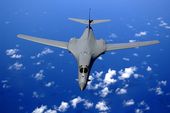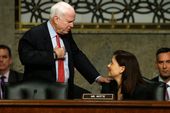Air Force
Latest Stories

hawaii_air_force_football.jpeg
Hawaii quarterback Dru Brown, front, eludes a tackle by Air Force defensive lineman David Harris in the first half of an NCAA college football game, Saturday, Oct. 22, 2016, at Air Force Academy, Colo. (AP Photo/David Zalubowski)

navy_air_force_football.jpeg
Air Force quarterback Nate Romine (6) passes during an NCAA college football game against Navy, Saturday, Oct. 1, 2016, in Air Force Academy, Colo. (Stacie Scott/The Gazette via AP)

air_force_colonel-rape_charge.jpeg
This Sept. 2014 photo provided by Schriever Air Force Base shows U.S. Air Force Col. Eugene Caughey taken at Schriever Air Force Base, Colo. Caughey, who was charged with rape and other alleged crimes, was found dead in his Colorado Springs, Colo., home, on Sunday, Sept. 25, 2016, according to city police and the Air Force. His court-martial was scheduled to begin on Oct. 17. (Christopher DeWitt/U.S. Air Force via AP)

B-1B_over_the_pacific_ocean
AIR FORCE - B-1B Lancer is a four-engine supersonic variable-sweep wing, jet-powered heavy strategic bomber used by the United States Air Force (USAF). It was first envisioned in the 1960s as asupersonic bomber with Mach 2 speed, and sufficient range and payload to replace the Boeing B-52 Stratofortress. It was developed into the B-1B, primarily a low-level penetrator with long range and Mach 1.25 speed capability at high altitude. It is commonly called the "Bone" (originally from "B-One"). Designed by Rockwell International (now part of Boeing), development was delayed multiple times over its history due to changes in the perceived need for piloted bombers. The initial B-1A version was developed in the early 1970s, but its production was canceled, and only four prototypes were built. The need for a new platform once again surfaced in the early 1980s, and the aircraft resurfaced as the B-1B version with the focus on low-level penetration bombing. However, by this point, development of stealth technology was promising an aircraft of dramatically improved capability. Production went ahead as the B version would be operational before the "Advanced Technology Bomber" (which became the B-2 Spirit), during a period when the B-52 would be increasingly vulnerable. The B-1B entered service in 1986 with the USAF Strategic Air Command (SAC) as a nuclear bomber. In the early 1990s, following the Gulf War and concurrent with the disestablishment of SAC and its reassignment to the newly formed Air Combat Command (ACC), the B-1B was converted to conventional bombing use. It first served in combat during Operation Desert Fox in 1998 and again during the NATO action in Kosovo the following year. The B-1B has supported U.S. and NATO military forces in Afghanistan and Iraq. The B-1B is expected to continue to serve into the 2030s, with the Long Range Strike Bomber to start supplementing the B-1B in 2030. (U.S. Air Force Photo by Staff Sgt. Bennie J. Davis III)

091815TrainHeroes.jpg
Secretary of Defense Ash Carter and Air Force Gen. Paul J. Selva, vice chairman of the Joint Chiefs of Staff, honor the three men, including two U.S. service members, who stopped a gunman on a Paris-bound train outside of Brussels last month.

091615HBD.jpg
The 312th Training Squadron gives the Air Force a birthday shootout

Screen Shot 2015-08-18 at 12.39.14 PM.png
Click on the image for the full view. (Image: Air Force)

INDONESIA.jpg
Firefighters and military personnel inspect the site where an Air Force cargo plane crashed in Medan, North Sumatra, Indonesia, Tuesday, June 30, 2015. An Indonesian Air Force Hercules C-130 plane with 12 crew aboard has crashed into a residential neighborhood in the country's third-largest city Medan. (AP Photo/Gilbert Manullang)

Air Port Hanger Foam.jpg
An Air Force hangar is filled with fire suppression foam system sprays during a test in Guam. (Image: U.S. Air Force) ** FILE **

AirForce.jpg
The Air Force has returned to flight duty the four B-1B crew members who dropped two bombs that killed five U.S. soldiers in Afghanistan in June — the deadliest "friendly fire" incident in the long war. (Associated Press)

3_172015_private-space-58201.jpg
The Falcon 9 SpaceX rocket lifts off at the Cape Canaveral Air Force Station in Cape Canaveral, Florida. For several years, SpaceX and ULA have engaged in a fierce battle to compete for lucrative contracts to launch national security satellites as part of the Air Force's Evolved Expendable Launch Vehicle program. (Associated Press)

3_162015_ap020606042538201.jpg
The Senate Armed Services Committee criticized the Air Force for not moving briskly enough away from older Russian rocket engines, a move many see as politically retaliatory for Moscow's actions in Ukraine. (Associated Press)

2_152015_ap1443675744938201.jpg
Senate Armed Services Committee Chairman Sen. John McCain, Arizona Republican, last week kept up his attack on the Air Force plans to shelve the A-10, calling them a "folly," after a USA Today report implied the plane is dangerous to friendly troops and civillians. The Air Force argues the deactivating the A-10s would save $4.2 billion. (Associated Press)

Mary Claire Caine.jpg
Mary Claire Caine, a female Air Force veteran in North Carolina, is outraged after she says a nasty note was left on her car when she parked in a space reserved for military members. (WECT)

12312014_ap7985433575768201.jpg
An Air Force Wings of Blue parachutist descends onto the gridiron before the Famous Idaho Potato Bowl NCAA game between Western Michigan and Air Force in Boise, Idaho, Dec. 20. (associated press)

AP9204010103
Comedian George Carlin joined the United States Air Force and was trained as a radar technician. He was stationed at Barksdale Air Force Base in Bossier City, Louisiana. He also began working as a disc jockey at radio station KJOE, in nearby Shreveport. Labeled an "unproductive airman" by his superiors, Carlin was discharged early on July 29, 1957. During his time in the Air Force he had been court martialed three times, and also received many nonjudicial punishments.

AP070123021514
Johnny Cash enlisted in the United States Air Force on July 7, 1950. After basic training at Lackland Air Force Base and technical training at Brooks Air Force Base, both in San Antonio, Texas, Cash was assigned to the 12th Radio Squadron Mobile of the U.S. Air Force Security Service at Landsberg, Germany as a Morse Code Intercept Operator for Soviet Army transmissions. It was there he created his first band, named "The Landsberg Barbarians." He was the first radio operator to pick up the news of the death of Joseph Stalin. He was honorably discharged as a Staff Sergeant on July 3, 1954, and returned to Texas. Singer Johnny Cash looks back to his days in the Air Force in 1952, on "The Johnny Cash Christmas Special," to be shown Nov. 30, 1977 on CBS-TV. (AP Photo/CBS-TV)

11132014_martha8201.jpg
Martha McSally, a retired Air Force colonel and a former A-10 fighter pilot, has won her race for a U.S. House seat in Arizona after all the votes were finally tallied.

b257e0b85fa16a2b640f6a7067003b34.jpg
This June 24, 2014, file photo, shows an ICBM launch site located among fields and farms in the countryside outside Minot, N.D. The Air Force on Monday, Nov. 3, 2014, fired two more nuclear commanders and disciplined a third. The actions were confirmed to the Associated Press in response to an AP inquiry about an internal Air Force investigation of two commanders at the 91st Missile Wing at Minot Air Force Base, N.D., which also is responsible for 150 Minuteman 3 missiles. (Associated Press)

10292014_ap1675231077168201.jpg
Senate Armed Services Committee members Sen. John McCain, Arizona Republican, and Sen. Kelly Ayotte, New Hampshire Republican, have criticized the Air Force's decision to retire the A-10 Warthogs in favor of keeping the B-1B aircraft in play as the A-10s are the only aircraft specifically devoted to close air support. Mr. McCain, himself a former Air Force pilot, was incensed upon first learning of the A-10's retirement.


